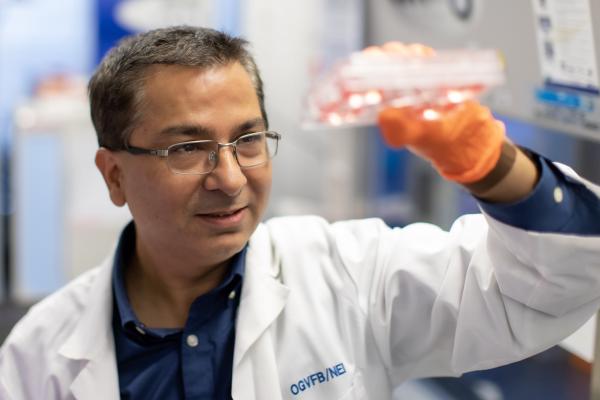With an Eye to the Future
Kapil Bharti is NEI’s New Scientific Director
BY DEVIKA BOSE, NEI
Kapil Bharti was named Scientific Director of the National Eye Institute (NEI) in May 2023. Bharti will support the NEI mission to eliminate vision loss and improve quality of life through vision research.
“Dr. Bharti is a world-class translational vision scientist, a thoughtful planner who understands interdisciplinary work, and an outstanding leader,” said NEI Director Michael F. Chiang to The Catalyst. “I am very excited about the energy and ideas he will bring to NEI, and about the collaborative opportunities with other institutes at NIH and beyond.”

CREDIT: DUSTIN HAYS, NEI
Kapil Bharti is NEI’s new Scientific Director
Bharti is best known for his research on degenerative eye diseases using induced pluripotent stem (iPS) cells. His lab continues to refine that technology and identify potential therapies for vision loss through collaborative work with the National Center for Advancing Translational Sciences.
Vision researchers have been among the first to embrace advanced technologies such as single-cell genomics, data science, and artificial intelligence to bring cell and gene therapies to patients. As scientific director, Bharti plans to continue that trend and use those and other cutting-edge techniques in new ways. “It is exciting for me to combine all these technologies to further both basic and translational vision science,” he said. And as a seasoned mentor, he has an eye toward the next generation. “[We need to] train our fellows not only to become dedicated scientists but also to become modern-era leaders that work on equity and diversity.”
Bharti’s journey at NIH started in 2004 as a Postdoctoral Fellow in Heinz Arnheiter’s lab in the National Institute of Neurological Disorders and Stroke. Arnheiter suggested books by evolutionary biologist Richard Dawkins and nurtured Bharti’s interests through lab projects, such as studying the roles of transcription factors MITF and PAX6 in eye development. Those two transcription factors regulate genes critical to the formation of a tissue called the retinal pigment epithelium (RPE)that supports the photosensitive part of the retina.
Bharti has since authored over 50 peer-reviewed papers and 30 reviews and book chapters. His work was among the first to 1) reveal the importance of cooperative actions of transcription factors in pigment biology and eye development (PLoS Genet DOI:10.1371/journal.pgen.1002757, 2012; PLoS Genet DOI: 10.1371/journal.pgen.1004360, 2014), 2) show the role of primary cilium in cell maturation (Cell Rep 22:189-205; DOI:10.1016/j.celrep.2017.12.038), 3) describe a path for an autologous iPS cell-based therapy (Sci Trans Med 11, 2019; DOI:10.1126/scitranslmed.aat5580), and 4) use artificial-intelligence-based cellular image analysis as a release criteria in cell therapy (J Clin Invest 130:1010-1023, 2020; DOI:10.1172/JCI131187).
Bharti was named NEI’s first Earl Stadtman Investigator in 2012. That year he started the Ocular and Stem Cell Translational Research Section, part of the Ophthalmic Genetics and Visual Function Branch (OGVFB). His lab uses RPE cells as an in vitro disease model for studying conditions such as age-related macular degeneration (AMD), late-onset retinal degeneration, and Stargardt disease. Patient RPE is generated by using iPS cells, which are created by collecting and then reprogramming a patient’s own blood or fibroblast cells.
According to OGVFB Chief Brian Brooks, Bharti has a reputation for innovation. For example, previous NEI Scientific Director Sheldon Miller designed a project in collaboration with Bharti to transplant an RPE patch created from an AMD patient’s stem cells to cure blindness. Because a major caveat of transplanting tissues and organs into humans is rejection, the scientists generated the AMD patient’s own stem cells in the lab. Bharti led a team that carried out preclinical studies for the RPE patch transplant, ultimately obtaining FDA approval for the procedure. In August 2022, an AMD patient at the NIH Clinical Center became the first person in the United States to successfully undergo an iPSC-RPE transplant.
Bharti’s early interest in biology was instilled by his mother, who was a science teacher. He earned a master’s degree in biotechnology at the Maharaja Sayajirao Rao University of Baroda (Vadodara, Gujarat, India) and his doctorate in molecular cell biology from Johann Wolfgang Goethe University (Frankfurt, Germany) in 2003. He credits his diverse educational background as foundational for his success in translational and collaborative research.
Outside of work, he enjoys jogging or sitting down to a good spy and political suspense show. And after hours, you might find him hanging out with lab colleagues at their regular haunts in downtown Bethesda.

Devika Bose is a molecular and stem-cell research associate in the National Eye Institute. She works in Kapil Bharti’s lab in the Ocular and Stem Cell Translational Research Section and uses stem-cell-derived RPE cells to study different retinal degenerative diseases. Outside of work, she enjoys traveling, cooking, hiking, binge watching programs on Amazon Prime, and reading.
This page was last updated on Wednesday, July 12, 2023
